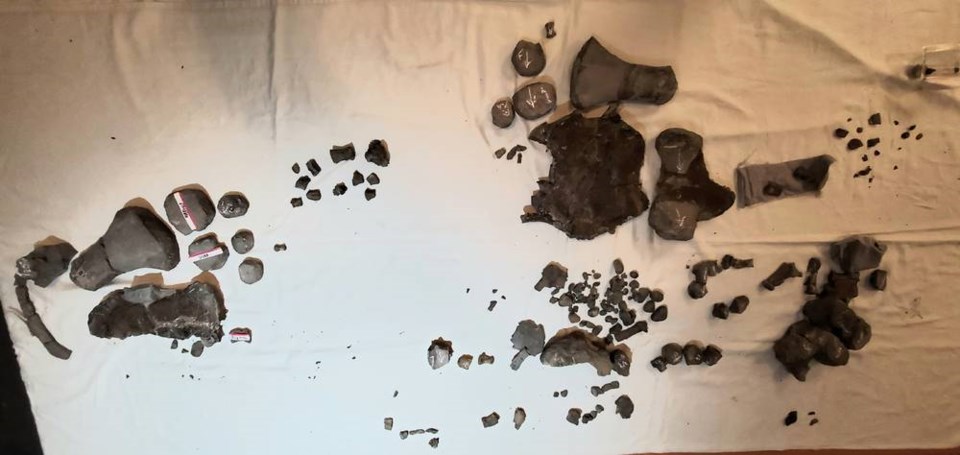Amateur paleontologist Pat Trask was walking along the banks of the Trent River, south of Cumberland and Royston, when he discovered what may be the fossilized remains of an elasmosaur, a small headed, long-necked creature with paddle-like limbs and a short tail.
“The fossil, which looked to me to be a rib cage, was sticking out of a cliff, about 10 metres above the ground, in plain sight,” said Trask, 64.
The area is well known to Trask, who serves as the natural history curator at the Courtenay and District Museum and Paleontology Centre, as it was less than 10 kilometres from where his twin brother, Mike, also discovered a fossil of the marine reptile in 1988. That fossil, discovered along the banks of the Puntledge River in Courtenay, was the first recorded in British Columbia and the first of its kind west of the Rockies. The first ever recorded was discovered in early 1867, in Kansas.
A model of Mike’s find now hangs at the Courtenay and District Museum.
But the joy at Pat’s discovery, which took place about two weeks ago, quickly turned into anxiety.
“It could easily have been poked at by a person with a long pole. I had nightmares about that.”
Over the weekend, he was able to return with helpers to safely retrieve the bones from where they have been resting for about 85 million years.
The area around the fossil was encased in plaster (referred to as jackets) and transported to the Courtenay and District Museum. Plans are to return to the site at a later date to see if there are any more remains of the animal to recover.
Trask estimates that he has roughly 60 per cent of a juvenile elasmosaur, about four metres long. His brother’s find was probably of an adult, measuring 12 metres.
While larger, his brother’s find was more corroded, probably due to the chemistry of the soil where it was resting.
Pat’s find might be more significant, as “its preservation is excellent.”
Even more significantly, his find might contain a full skull, which he thinks might lie under the body. If so, it might mean it could be identified as a new species. His brother’s find was missing most of its skull, making that determination impossible.
“Right now it only has a generic name, as an elasmosaur,” said Trask. “The name of this new species can be up for grabs. My hope is that they name it after the province — or my family. It would be a great honour.”
The area where the fossil was found is known as the Nanaimo Group, formed during the latter part of the Cretaceous Period (from around 60 to 85 million years ago).
At the time, the area on the east coast of Vancouver Island from Duncan to Campbell River was a marine environment.
According to Natural Resources Canada, the region is made up of 11 formations of deposited sedimentary rock. It includes alternating layers of conglomerate, sandstone separated by mudstone and fine-grained sandstone. It has a total thickness of up to 5,000 metres. This same formation is responsible for the abundance of coal deposits in the region.
“The find really shows there is stuff in the province yet to be discovered and learned from,” said Victoria Arbour, curator of paleontology at the Royal B.C. Museum.
She says finding a vertebrate (a creature with vertebral column or spine) rather than an invertebrate, a fossilized marine animal without a backbone or bony skeleton, is much more rare in this area.
Information on marine creatures such as the elasmosaur isn’t as rich as for land-based animals, Arbour said, because they don’t have any close living relatives.
Between this find and the earlier one, the Courtenay and District Museum and Paleontology Centre has become the go-to museum for marine animals. The Royal B.C. Museum has a larger invertebrate collection, by comparison.
While the fossil is safe with the Courtenay museum, it might be years before it will be ready for public viewing.
Most of the bones are still encased in rock and need the services of a preparator — a technician skilled in fossil preparation.
“The hope is that we have a hard fossil in soft rock, not the other way around,” said Arbour. “Fossils are really easy to break and can crumble when removed.”
The remains will be the subject of study by scientists, while someone with manual dexterity and good observational skills works slowly with a scalpel, brushes and glue to bring the creature back to life.
Arbour says some of the best preparators are also artists.
While the location of the find on the banks of the Trent River is known to locals, Trask is hesitant to pinpoint the exact location because he doesn’t want the site disturbed.
In B.C., fossils on Crown land are the property of the Crown and cannot be sold or exported outside the province without prior authorization.
In some cases, fossils on privately owned land also remain the property of the province.
Collectors are allowed to obtain small amounts of fossils for recreational purposes. Only common types of fossils that are available in quantity and not considered scientifically significant can be collected, however.
All vertebrate fossils are considered significant and sites must be reported to the government.
The permission to collect common fossils on Crown land is for surface collection only. The use of small hand tools is allowed but no excavation is permitted.
When unusual or rare specimens are discovered or when only small quantities of fossils are present at a site, collectors must report findings to the Royal B.C. Museum, a local museum or the B.C. Fossil Management Office.
“If you find a fossil, just take a picture, mark the location of the find and contact us,” said Arbour. “When you don’t, the scientific community loses valuable information about the discovery.”
